HOW CLIVE CAPTURED THE GAME’S MOST ICONIC IMAGE
Mike Williamson called it. Clive Mackinnon snapped it . . . and has there been a more iconic football photograph taken than Alex Jesaulenko’s mark over Graeme Jenkin, as captured by Clive almost 50 years ago?
Today, just 28 days after Williamson’s death, Mackinnon has gone to that darkroom in the sky, having died of a heart attack in Geelong hospital last Wednesday at the age of 89.
But he leaves behind a glorious illustrative legacy that will endure for as long as the great Australian game is played.
Back in 2009, Clive reflected on the mark he almost missed, in an interview with this reporter for the publication Out of the Blue.
The following is an edited extract.
Early on the afternoon of Grand Final day 1970, the man who would soon capture the game’s most iconic image on film lugged his lens and his tripod to the first tier of the then Western Stand.
This was no easy task for The Sun News-Pictorial’s second-year photographer Clive Mackinnon, having to haul an 80-pound camera and its support to his precarious vantage point in the front row, high above the half-forward flank by the old Smoker’s Stand at the city end of the MCG.
“You had to put a strap around your neck to take the strain of the weight,” Mackinnon recalled.
“The camera was more like a gun, it weighed a fair bit, and if you had a fall carrying it you got seriously hurt.”
With an all-time record football audience of 121,696 people jam-packed into Jolimont’s sardine tin for the surreal occurrence that was the Carlton-Collingwood Grand Final, Mackinnon somehow manoeuvred his way into pole position - alongside fellow snappers Bruce Howard of The Herald and Denis Bull of The Age - both of whom were shooting with similar beasts.
There they shot whatever they saw below, swinging their lenses left or right of centre in unison, depending on where the frenzied air conveyance flew.
Then, about 27 minutes into the second quarter, when Alex Jesaulenko launched himself onto the shoulders of Graeme Jenkin and into football immortality, came Mackinnon’s “Minties moment”.
“Denis Bull was a terrific bloke . . . and he was a bit of a fang man too. You wouldn’t have wanted to be standing behind him in the queue for a pie,” Mackinnon explained.
“Now late in the second quarter, when the play had drifted down into to Carlton’s defence, Denis reached into his bag and passed a Mintie to me and Bruce. I wasn’t particularly interested in eating anything because I was too busy shooting, but I hurriedly opened the Mintie.
“All of a sudden I looked up and said ‘Look out, the ball’s coming back. Without thinking, I quickly put the Mintie and the paper in my mouth because ‘Jezza’ was setting himself and I knew he had his name written on it [the football ball].
“I sought of gulped when I took the photo and the Mintie went down, but it took a while to go down and I thought I was going to die. For memory, Bruce was in a bit of trouble too because I reckon he got a Mintie jammed in his throat.
“These days you can keep firing with a big mark, back then you couldn’t do it, but we all got the shot – which is why we all stood and shook each other’s hands. All the supporters sitting around us cheered for us too, because they’d seen the mark and knew that we’d got it, but to be truthful we should have been trying to get the shot of Jezza with the ball as he came back to the ground.
“It was one of those times I will always recall taking the picture.”
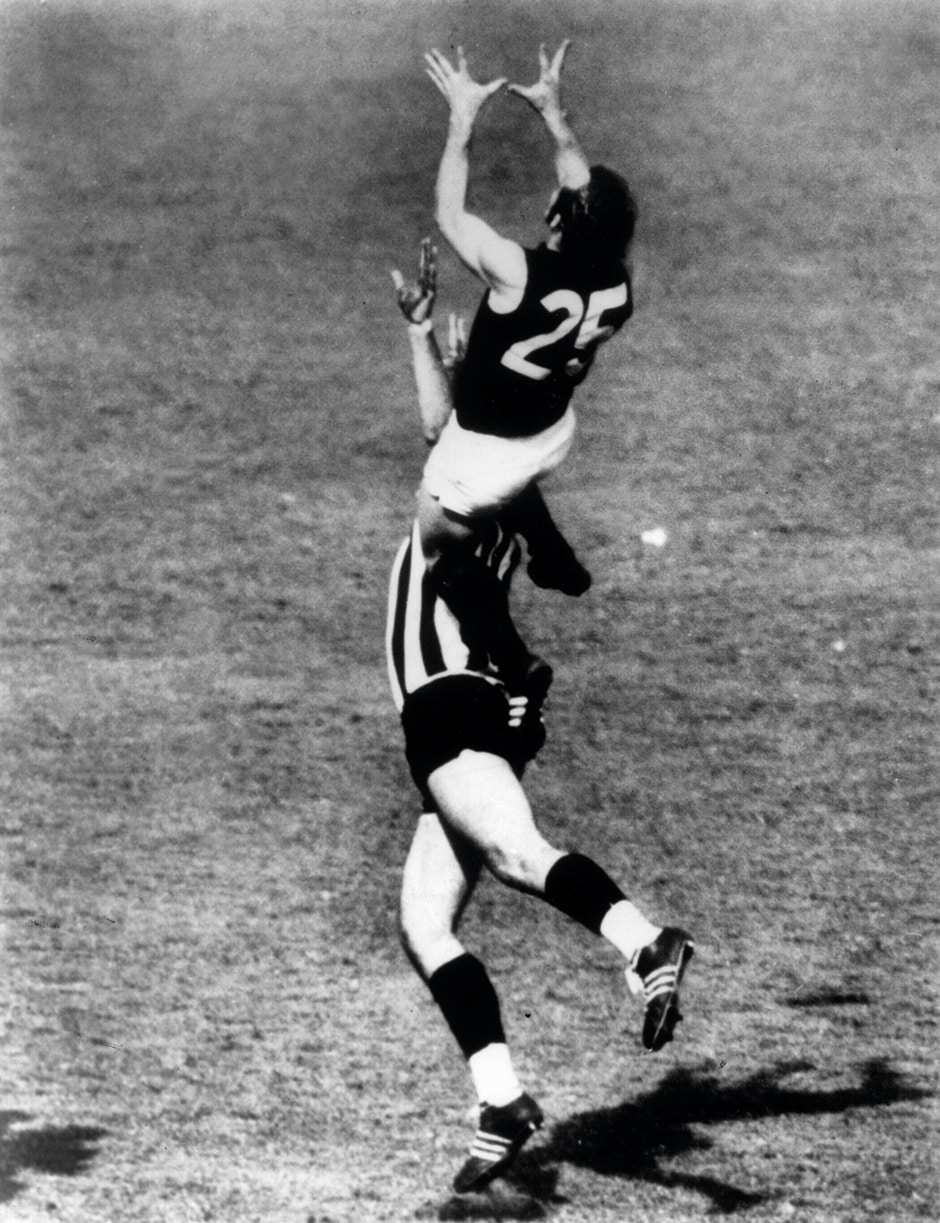
The magical mark captured in all it's glory by Clive Mackinnon.
Mackinnon conceded that whenever photographers get together over a convivial ale, debate still rages over who took the best image of the Jesaulenko mark. Was it The Australian’s snapper Alan “Spider” Funnell - the only photographer to capture Jesaulenko’s mark front-on? Or the late Rene Ellis, who seized the moment in colour as part of a glorious ground level panorama? Perhaps Howard and Bull, who each caught Jesaulenko with the football in the frame as Carlton’s famed No.25 commenced his descent?
Mackinnon’s image, which first appeared in The Sun on the Monday after the 1970 Grand Final, depicts Jesaulenko at the highest point of his leap, but with no footy – at least not in the vertical which graced the newspaper’s back page.
“Part of the football does appear on the edge of the original negative, but Dallas Swinstead, the then Sports Editor of The Sun wouldn’t let me include it,” Mackinnon said.
“The fact that the football wasn’t in the cropped print was what Dallas liked about it. He liked the way that that Jezza’s fingers were spread and he thought of the photo as a terrific instructional tool for kids wanting to take the high mark. He was right too, for even now when I go to watch junior footy, if someone takes a bit of a flyer, ‘Jezza’s name still crops up.
“The sun was directly over Jesaulenko’s head at that moment, and not many people would realise this, but if you look closely to the lower right of the photo, you will see there’s a small shadow to the top of Jenkin’s shadow . . . and that’s the shadow of the footy.”
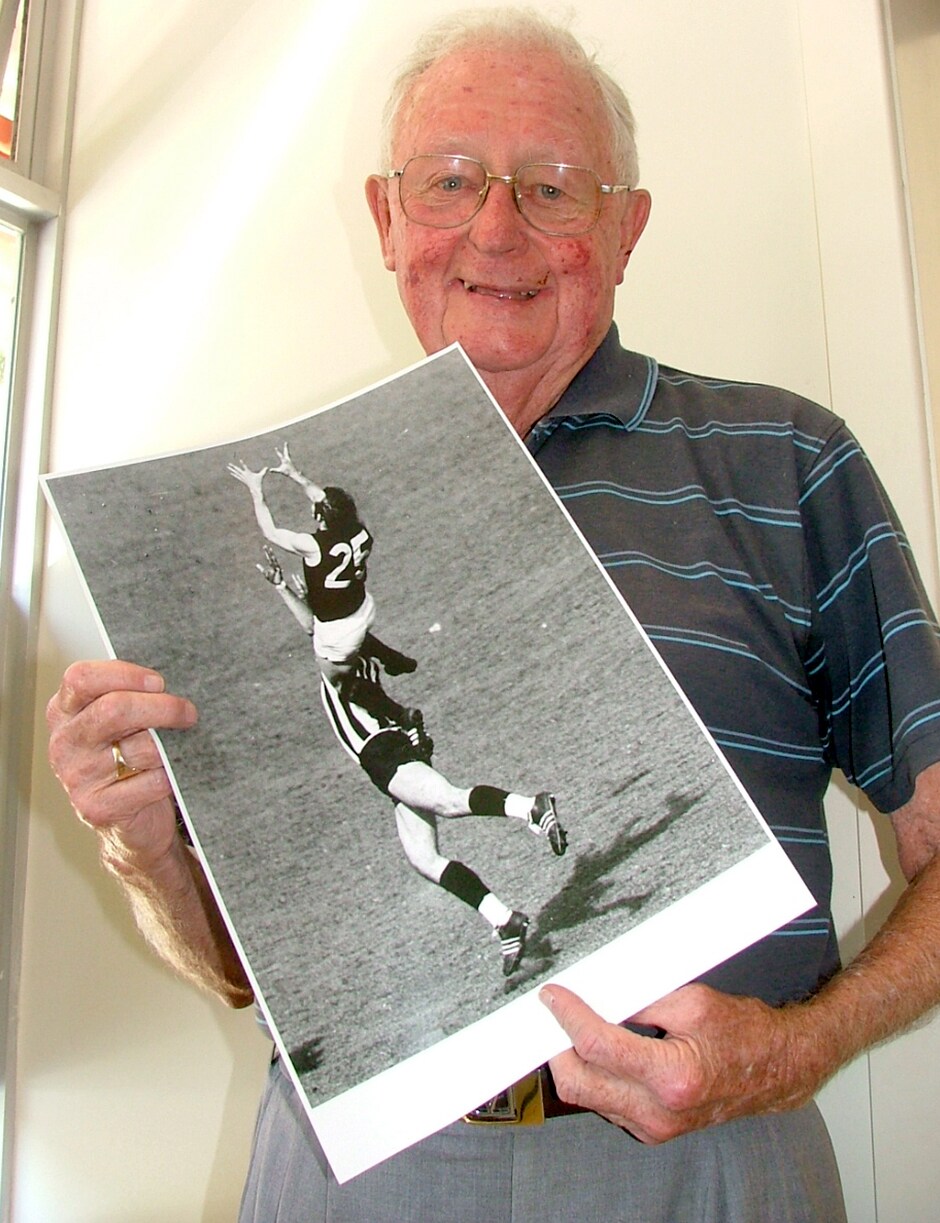
Mackinnon and his prized photo.
Mackinnon rates the Jesaulenko image on a par with two other sporting images as the best captured by his lens - one of Carl Lewis, the other of Jack Nicklaus. The three photographs take pride of place side by side by side on the wall of his kitchenette at his home on the Bellarine Peninsula “and it’s not a bad trifecta I reckon”.
He rates Jesaulenko’s mark extremely highly in its own right “because I’ve seen it on television so many times and it gets you in . . . but I don’t think it’s the best mark”.
“Bill Ryan took one in a final for Geelong against St Kilda. He came in from behind, launched himself over the pack and ended up head over heels . . . it’s by far the best mark I’ve seen,” Mackinnon said.
In saying that, Mackinnon believed that the Jesaulenko mark had endured “because Jezza got so high”.
“Funny thing, Jezza used to say that there were other instances where he got up higher, and I’m not sure if he was joking,” Mackinnon said.
The mark has meant many things to many people. The then Carlton Coach Ron Barassi, perched high in the MCC’s Smoker’s Stand that afternoon, remembered exactly how he felt when Jesaulenko launched himself northward. Said Ronald Dale: “The best thing about Jezza’s mark was that we kept possession”.
David McKay, whose torpedo punt kick somehow found its way into Jesaulenko’s incredible grasp, said it still amazes him that the catchcry “Jezza” reverberates the school ground when for any young kid launches for the elusive ‘specky’ in the schoolground or neighbouring park.
“The image has also been used to promote the mark of the year too, which guarantees the recipient far more materially than it did for Jezza back in 1970,” said McKay.
Or, for that matter, Mackinnon.
“If you took that picture now you’d make a lot of money, but I don’t think I’ve made a zac out of it,” said Mackinnon. “Cadbury made wrappers out of the pictures using my image and they did send me a box of chocolates, but the chocolates are gone now , and all I’ve got is the empty box.”
Note: Generous to a fault, Clive also availed Carlton-centric black and white photographs he captured and captioned from as far back as September 1957, when a hailstorm hit the MCG at half-time of the first semi-final between Carlton and Hawthorn.
They appear as follows;
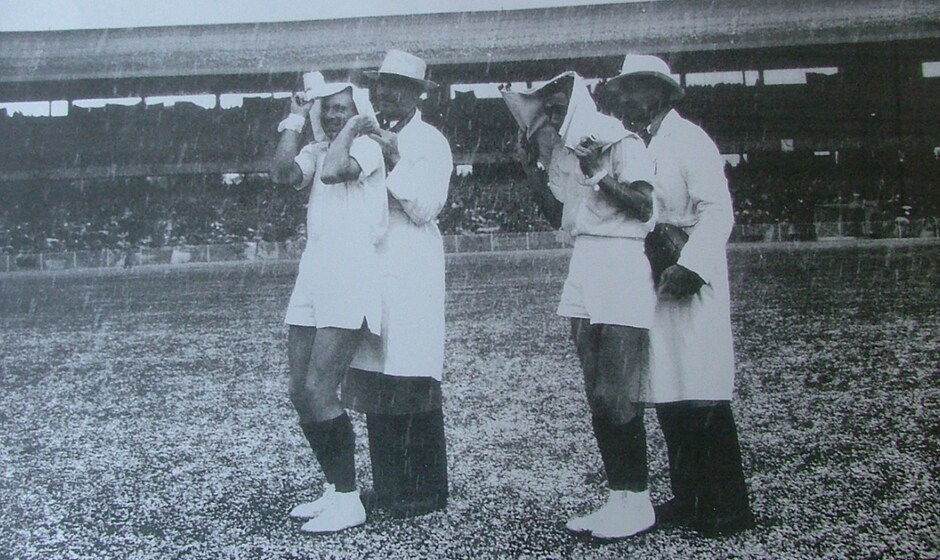
Half-time hailstorm, 1957 first semi-final
Mackinnon’s caption: “During the break, tremendous hailstones hit the oval. The umpires had just come out to continue the game. The players had not come out and the umpires were forced to protect themselves, with the help of the goal umpires, by covering their heads with the flags for several minutes. When I carefully chose my path to take this picture, my camera under my big plastic coat, there wasn’t a policeman in sight. Nearly all the spectators were thinking “What’s this idiot going to do?”. I suddenly produced my camera and the crowd roared its approval and cheered my act. I waved to all of them and hurried off the MCG oval. Unfortunately minutes later, while trying to get shots of play on the ice-covered ground, I slipped on the ice and fell forward, badly smashing my face on the camera. It was the first time I was assisted by trainers. I kept working, but I didn’t feel too good.”

Bruce Doull consoles Peter Moore, post-siren, 1979 Grand Final
Mackinnon’s caption: “Bruce Doull, minutes after Carlton had beaten Collingwood in the VFL, pauses to commiserate with a disappointed champion Peter Moore, who was really down in the dumps. It speaks volumes for Doull, who in the excitement still found time for a great player.”
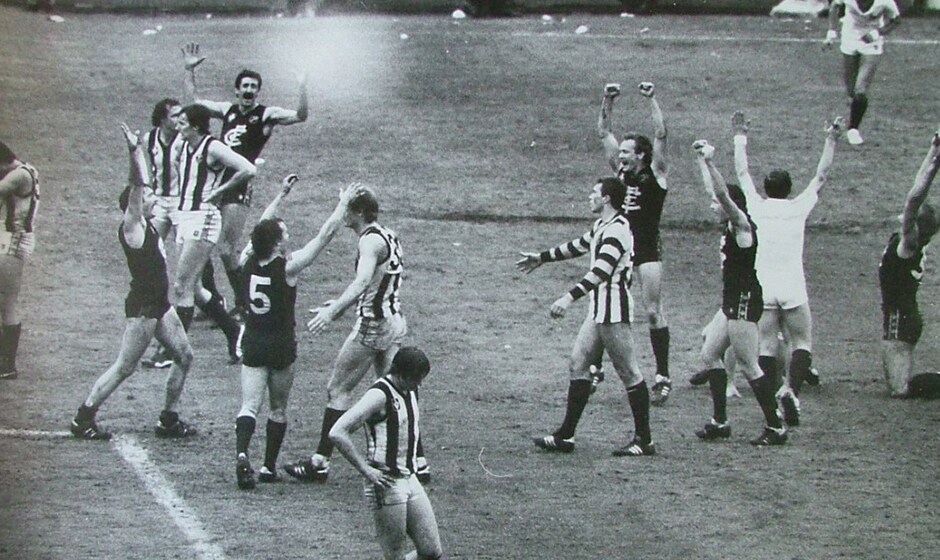
Siren time, 1981 Grand Final
Mackinnon’s caption: “Winners and losers are easy to pick when the siren ends the 1981 Grand Final, with Carlton 12.20 (92) defeating their old rivals Collingwood 10.12 (72). Bill Picken (Coll) front centre of pic, is clearly a loser, while six sets of raised Carlton players’ arms obviously announce the victors.”
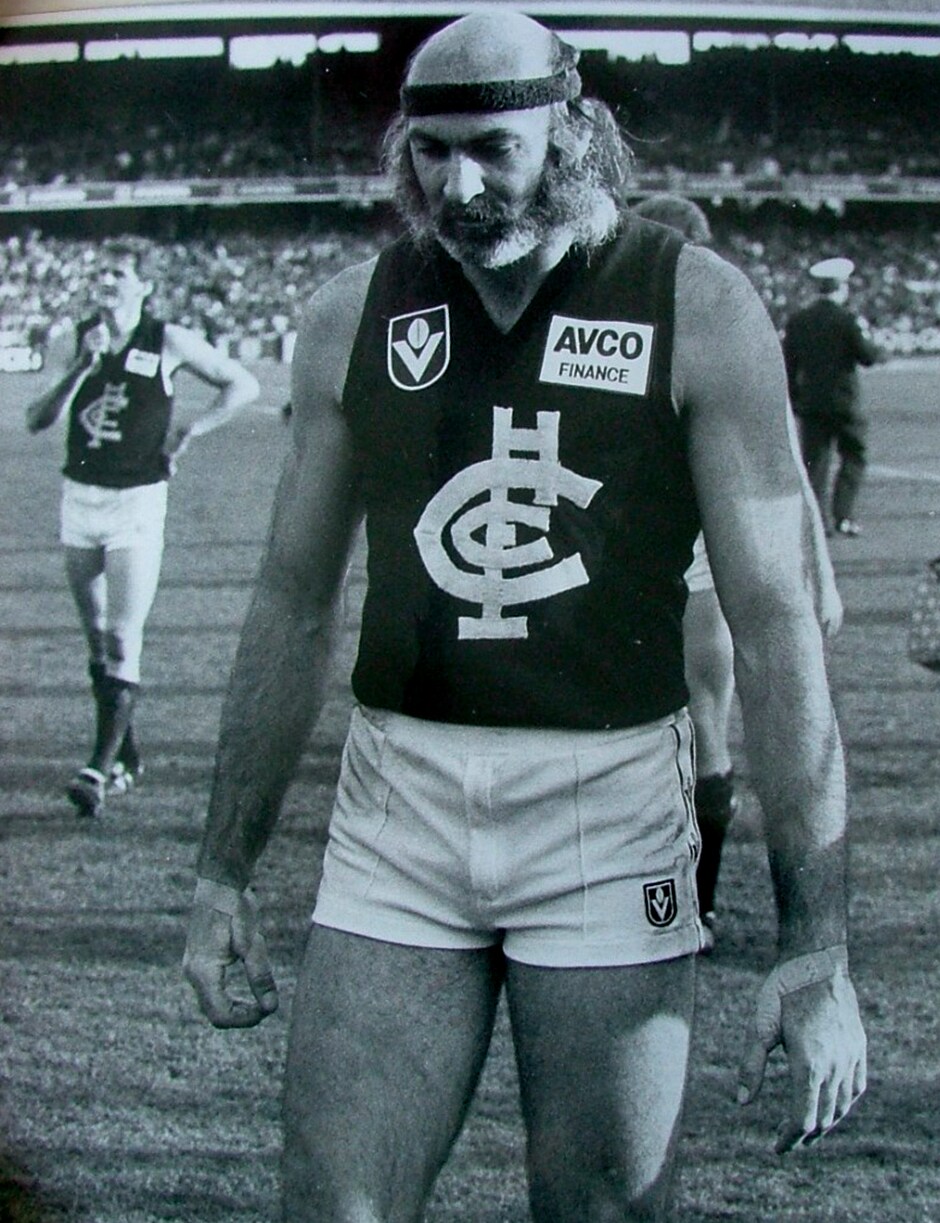
Bruce Doull’s last hurrah, Grand Final day 1986
Mackinnon’s caption: “It has become almost a tradition for teammates to carry off a retiring champion. It’s a salute from the players and gives the club followers an opportunity to acclaim the player and his great deeds of the past. Nearly all of the 101,861 fans that were at the 1986 Grand Final, opposition players included, gave an instantaneous testimonial to one such player . . . he chose to walk off, not to be carried off. It must have been the longest walk in his great career. After 359 games, Carlton’s 36 year-old hero, ‘The Flying Doormat’ Bruce Doull, had played his last game. Hawthorn had just beaten his beloved team, Carlton, 16.14 (110)-9.14 (68). For Carlton Members it was a double disaster – they had lost a Grand Final and one of the greatest Carlton champions ever to play.”



